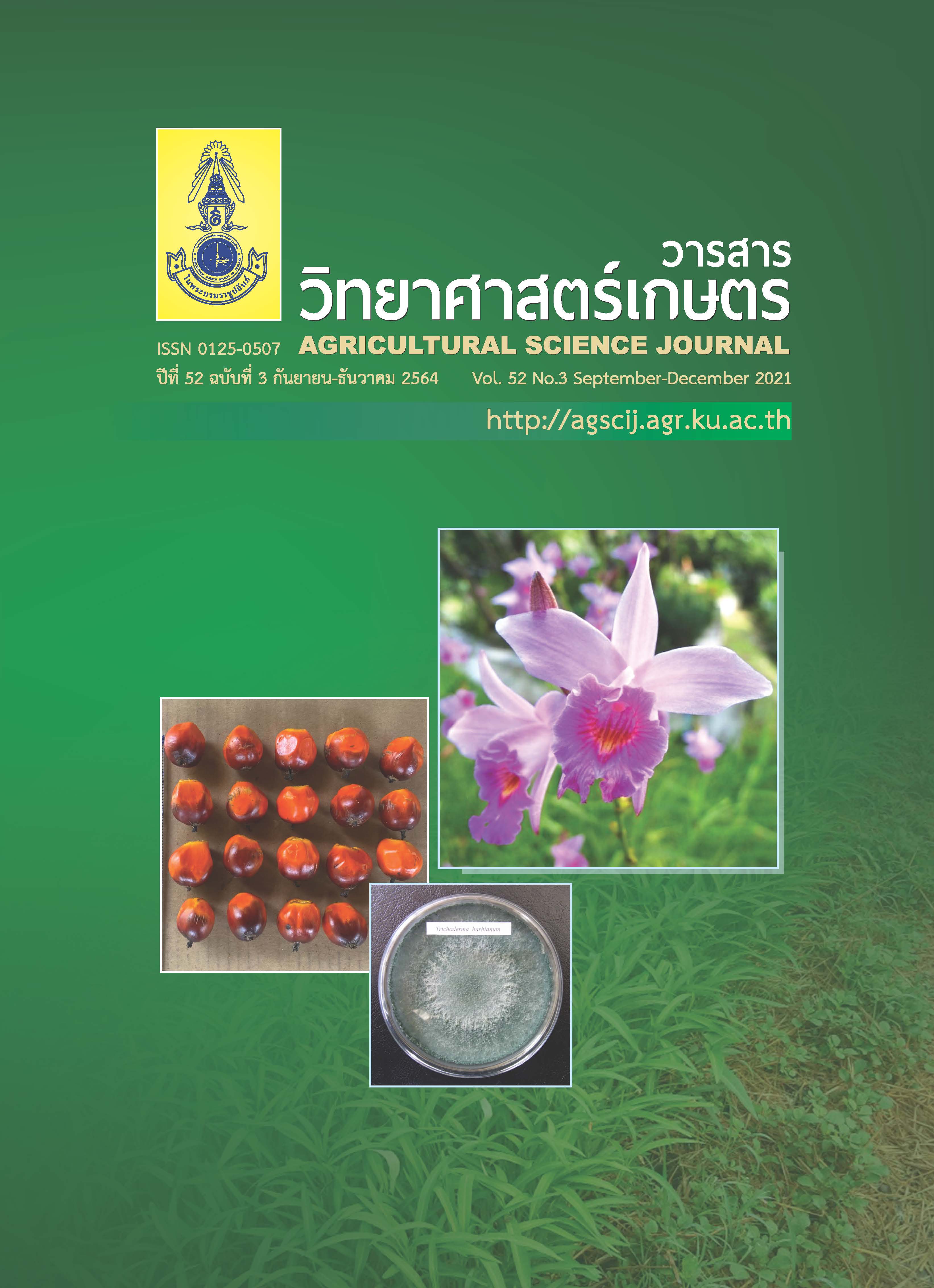ผลของการให้น้ำแบบน้ำหยดบนดินและใต้ผิวดินด้วยระบบอัตโนมัติที่มีต่อผลผลิตของมันสำปะหลังเก็บเกี่ยวอายุสั้นที่ปลูกปลายฝน
Main Article Content
บทคัดย่อ
การให้น้ำแบบน้ำหยดทำให้การเจริญเติบโต ผลผลิต และเปอร์เซ็นต์แป้งเพิ่มขึ้น ทำให้สามารถลดระยะเวลาในการเพาะปลูกและค่าใช้จ่ายในการควบคุมศัตรูพืชในการเพาะปลูกมันสำปะหลัง การทดลองนี้ศึกษาผลของการให้น้ำแบบน้ำหยดต่อการสะสมน้ำหนักแห้งและผลผลิตของมันสำปะหลังที่ปลูกช่วงต้นของฤดูปลูกปลายฝน (LRS1) ในเดือนตุลาคมและช่วงปลายของฤดูปลูกปลายฝน (LRS2) ในเดือนธันวาคม โดยเก็บเกี่ยวผลผลิตที่อายุ 8 เดือนหลังปลูก ใช้แผนการทดลองแบบสตริปพลอท (Strip plot design) จำนวน 4 ซ้ำ ปัจจัยแนวตั้ง คือ วิธีการให้น้ำแบบน้ำหยดใต้ผิวดิน (SDI) น้ำหยดบนดิน (DI) และการปลูกโดยอาศัยน้ำฝนตามธรรมชาติ (RF) ให้น้ำแบบอัตโนมัติตามความชื้นดินโดยรักษาระดับแรงดึงความชื้นของดินให้อยู่ระหว่าง -30 ถึง -60 กิโลพาสคาล ปัจจัยแนวนอน คือ พันธุ์มันสำปะหลังพันธุ์เกษตรศาสตร์ 50 (KU50) และห้วยบง 80 (HB80) ผลการทดลอง พบว่า ที่อายุ 8 เดือนหลังปลูก มันสำปะหลังที่ให้น้ำแบบ SDI มีความสูงต้นมากกว่า DI และ RF ในวันปลูก LRS1 ขณะที่ การให้น้ำแบบ SDI และ DI ทำให้มันสำปะหลังมีความสูงต้นมากกว่า RF ในวันปลูก LRS2 (P < 0.01) การให้น้ำแบบน้ำหยดทั้ง 2 วิธี ให้น้ำหนักแห้งส่วนต้น เหง้า และหัวสูงกว่า RF ในการปลูกทั้ง 2 วันปลูก (P < 0.01) วันปลูก LRS2 ให้ผลผลิตเฉลี่ยสูงกว่า LRS1 การให้น้ำทั้ง 2 วิธี ทำให้ผลผลิตและเปอร์เซ็นต์แป้งสูงกว่า RF (P < 0.01) ขณะที่ ผลผลิตและเปอร์เซ็นต์แป้งของมันสำปะหลังพันธุ์ KU50 และ HB80 ไม่แตกต่างกันในทั้ง 2 วันปลูก การให้น้ำแบบ SDI ให้ผลผลิตและประสิทธิภาพการใช้น้ำสูงที่สุดในการเพาะปลูกมันสำปะหลังเก็บเกี่ยวอายุสั้นที่ปลูกปลายฝน
Article Details

อนุญาตภายใต้เงื่อนไข Creative Commons Attribution-NonCommercial-NoDerivatives 4.0 International License.
เอกสารอ้างอิง
Alves, A.A.C. 2002. Cassava botany and physiology, pp.67–89. In R.H. Hillock and J.M. Thresh, eds. Cassava: Biology, Production and Utilization. CAB International, Wallingford, England.
Bakayoko, S., A. Tschannen, C. Nindjin, D. Dao, O. Girardin and A. ASSA. 2009. Impact of water stress on fresh tuber yield and dry matter content of cassava (Manihot esculenta Crantz) in Côte d’Ivoire. Afr. J. Agric. Res. 4(1): 21–27.
Chuayprut, N., S. Nakasathien, E. Sarobol, V. Vichukit, C. Thongjoo, S. Tubnguen, S. Kaewrueng and C. Chutteang. 2017. Yield of cassava grown in beginning of early rainy season under supplemental subsurface-dripped and surface-dripped irrigations in comparison to natural rainfed condition. Agricultural Sci. J. 48(3): 346–357. (in Thai)
Connor, D.J., J.H. Cock and G.E. Parra. 1981. Response of cassava to water shortage. I. Growth and yield. Field Crop Res. 4: 181–200.
Department of Agriculture. 2020. Handbook of Cassava Production Technology. Department of Agriculture, Ministry of Agriculture and Cooperatives, Bangkok, Thailand. (in Thai)
Department of Agriculture. 2021. Suggestion of Fertilizer Based on Soil Analysis for Economic Crops. Department of Agriculture, Ministry of Agriculture and Cooperatives, Bangkok, Thailand. (in Thai)
El-Sharkawy, M.A. 2004. Cassava biology and physiology. Plant Mol. Biol. 56: 481–501.
Hular-Bograd, J., E. Sarobol, C. Rojanaridpiched and K. Sriroth. 2011. Effect of supplemental irrigation on reducing cyanide content of cassava variety Kasetsart 50. Kasetsart J. (Nat. Sci.) 45: 985–994.
Janket, A., N. Vorasoot, B. Toomsan, W. Kaewpradit, S. Jogloy, P. Theerakulpisut, C.C. Holbrook, C.K. Kvien and P. Banterng. 2020. Starch accumulation and granule size distribution of cassava cv. Rayong 9 grown under irrigated and rainfed conditions using different growing seasons. Agronomy. 10(3): 412.
Lamm, F.R., H.L. Manges, L.R. Stone, A.H. Khan and D.H. Rogers. 1995. Water requirement of subsurface drip-irrigated corn in Northwest Kansas. Trans. ASABE. 38(2): 441–448.
Land Development Department. 2021. Group of soil series No. 35. Available Source: http://iddindee.ldd.go.th/SoilSeries/M/18_Series_(Mb).pdf, October 6, 2021. (in Thai)
Maneechote, C., S. Sahaya, P. Ekkathin and Y. Anantanamanee. 2016. Integrated Pest Management of Cassava Manual. Karuntee Press, Bangkok, Thailand. (in Thai)
Numkhang, P. 2012. The Study on Water Requirement and Optimal Water Application to Cassava. MS Thesis, Kasetsart University, Bangkok. (in Thai)
Odubanjo, O.O., A.A. Olufayo and P.G. Oguntunde. 2011. Water use, growth, and yield of drip irrigated cassava in a humid tropical environment. Soil & Water Res. 6(1): 10–20.
Olanrewaju, O.O., A.A. Olufayo, P.G. Oguntunde and A.A. Ilemobade. 2009. Water use efficiency of Manihot esculenta Crantz under drip irrigation system in South Western Nigeria. Eur. J. Sci. Res. 27(4): 576–587.
Polthanee, A. and M. Srisutham. 2018. Growth, yield and water use of drip irrigated cassava planted in late rainy season of North Eastern Thailand. Indian J. Agric. Res. 52(5): 554–559.
Sinobas, L.R. and M.G. Rodríguez. 2012. A review of subsurface drip irrigation and its management, pp. 171–194. In T.S. Lee, ed. Water Quality, Soil and Managing Irrigation of Crops. Intech publisher, London, England.
Sinworn, S. 2014. Effect of Drip Irrigation Systems Fertigation and Soil Fertilization on Growth and Yield of Cassava. MS Thesis, Kasetsart University, Bangkok. (in Thai)
Sinworn, S. and P. Duangpatra. 2014. Effect of drip irrigation systems and chemical fertilizer on growth and yield of cassava in dry season. SDU Res. J. 7(2): 1–21. (in Thai)
Thongaram, D., W. Tangkosakul, N. Jiracheewee and I. Nuntagij. 2002. Design and Technology of Irrigation for Plant. Mitkaset Marketing and Advertising Press, Bangkok, Thailand. (in Thai)
Umair, M., T. Hussain, H. Jiang, A. Ahmad, J. Yao, Y. Qi, Y. Zhang, L. Min and Y. Shen. 2019. Watersaving potential of subsurface drip irrigation for winter wheat. Sustainability. 11(10): 2978.
Wanikorn, N. 2007. Effect of Varieties, Harvesting Dates and Planting Season on Starch Biosynthesis of Cassava. PhD Thesis, Kasetsart University, Bangkok. (in Thai)
Xie, X. 2018. Fertigation for Cassava Production under Drip Irrigation System. PhD Thesis, Suranaree University of Technology, Nakhon Ratchasima.


